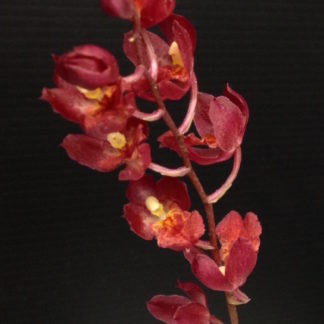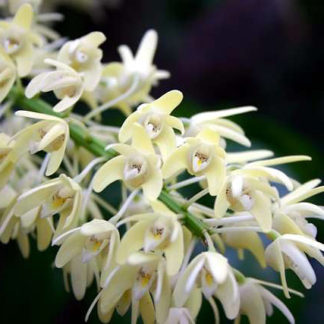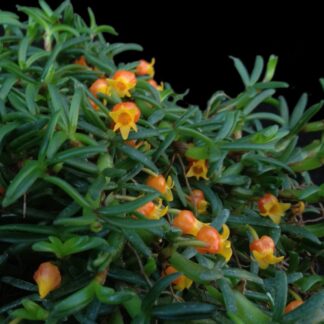Description
IMPORTANT NOTE: these plants are NOT IN BUD/BLOOM when shipped. They come in 2.25-inch square pots. These is a MINIATURE orchid species that can reach Blooming Size in these 2.25-inch square pots, but plants are NOT IN-BUD/BLOOM when shipped. PLEASE look at all the pictures in this listing so you know the condition/size of plant you’ll be getting.
It is a commonly accepted fact of botany that the Orchid Family (Orchidaceae) is the second-largest family of flowering plants on the planet, if we’re only counting species. The count for the two top contenders is surprisingly close, with Asteraceae (i.e., think daisies and sunflowers) currently having the lead by only around 2000 species. Well, my bet is on orchids to eventually surpass the Asteraceae, and the curiously-named, but very delightful, Encyclia bohnkiana is one reason why. (A quick point of clarification: species are what you find naturally, hybrids are what you get when you breed different species or different hybrids together.)
New orchid species have been systematically described since the 1700s, and the number of ‘discovered’ orchid species has reached nearly 30,000, although this depends on how you count them. As usual when talking about orchid species, a good analogy is dog breeds (and the astute and pedantic amongst you will point out that all dogs are one species, not multiple, but let’s just go with it for now, please). There are two terrier breeds in England which look practically IDENTICAL, except that one breed has dropped ears, and the other has erect ears (Norfolk and Norwich, respectively). Now how is it that these two breeds which are practically exactly the same except for a gene variant or two causing the drop ears/erect ears trait are classified as different breeds?
It’s because someone(s) did the classifying, and probably a bit of lobbying and politicking with the Kennel Club (England). The point here is that classifying is something that people do, and if there’s one thing that people are extremely good at, it’s disagreeing. So in the orchid world, there are numerous examples of this Norfolk/Norwich Terrier effect, where you have essentially the same species of plant but with variations — one is short, and one is tall, or one has spots on the lip, and the other doesn’t, or one grows 1000 meters up the mountain and has a slightly wider leaves whereas the lowland variety has skinnier leaves, etc… This is not an exaggeration: it is EXACTLY like this. In the orchid world, people who care about this stuff (and there are PLENTY) fall into two camps, the ‘lumpers’ and the ‘splitters’. Obviously, the Norfolk Terrier folk are splitters.
So back to Encyclia bohnkiana… It was officially described in 1999 (i.e., usually by publication in a scientific journal), which means it was discovered not too long ago. With over 200 years of searching for orchids, there are STILL some being discovered today, and while the rate of new discoveries has slowed, there must be many, many more out in the jungles of the world waiting for people to find and classify them. That very fact, plus the possibility of splitting different forms of the same species into TWO species (or maybe even more), AND the proven and enduring rabid devotion of orchid folk through the centuries, virtually guarantees that we orchid-folk will come out on top as the largest family of flowering plants on Earth. Eventually. (Yes, there might be plenty of unclassified/undiscovered Asteraceae out in the wild, but discovery is done by people, and people are generally much more interested in orchids, and hence more likely to be looking for orchids, or at least supporting expeditions to find them.)
Encyclia bohnkiana hails from the northeastern part of Brazil. It comes from a warm, humid environment, so if you’re growing indoors, you’ll want to keep it in high humidity conditions, preferably a terrarium/vivarium or a humidity chamber (which is as simple as a clear plastic storage container from Target placed over the plant — it’ll do wonders for your orchids, trust me). The flowers open up to about the size of a dime, and are a lovely lime green with a white lip. You can grow these mounted on a piece of wood or bark if you wrap a ball of sphagnum moss around the roots and tie it in place with monofilament fishing line. Just make sure humidity is at least 70%, or the plant will eventually slowly decline.
As a miniature plant, it easily reaches Blooming Size in a 2.25-inch square pot (see photos).
PLEASE NOTE: these plants are NOT in-bud/bloom when shipped.









